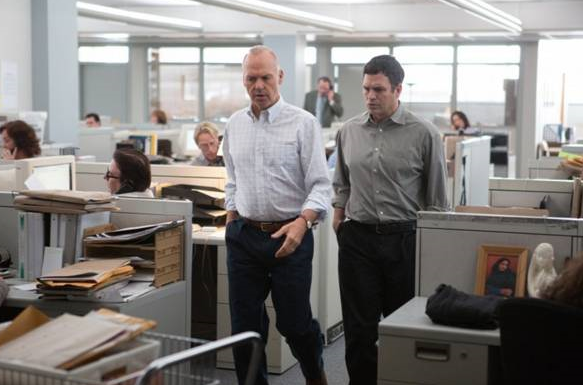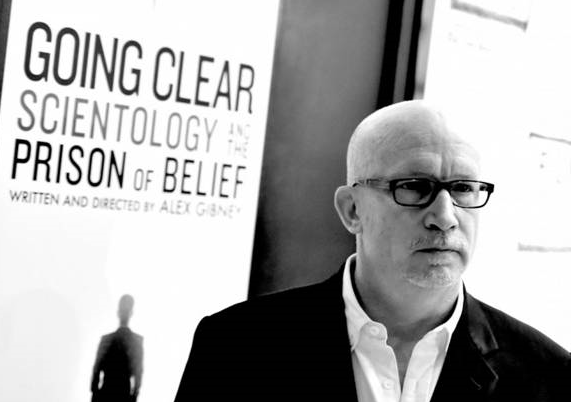
Michael Keaton as Walter ‘Robby’ Robinson and Mark Ruffalo as Michael Rezendes in “Spotlight”. (Kerry Hayes/Open Road Films)
Abusive religious extremism is not entertaining. It’s painful. It’s ugly. It makes us angry.
So why is it everywhere in film and TV this year?
From ISIS-driven atrocities to sex abuse scandals and the never-ending stories about the Duggar family, the news has been full of examples of seemingly normal people getting suckered into cults and extremist religion. But it didn’t stop with the news. On TV and at the movies, we’re asking over and over: How on earth do people end up there, and why in the world do they stay?
Which brings up another set of questions: Why are we watching? Is it a morbid curiosity about others? Is it the kind of fascination with train wrecks that drives reality TV?
Certainly this is part of it, but there has to be more. Because they are image-driven, films and TV shows are good at putting specific faces on abstract issues. Once we see and hear a former adherent talk about their experience, we realize that normal, intelligent people get sucked in (and stay). But it’s still baffling. We might be tempted to think of it in the way some blame victims of domestic abuse for not just leaving. How could you stay?
Maybe the answer to that question — and the fear that it will happen to us — keeps us watching. Religion is creeping back into our collective consciousness after a few decades of hiatus. Is it possible that in a flourishing spiritual marketplace, fanaticism could even be appealing?
In October, the Showtime documentary “Prophet’s Prey” released on the cable channel after a Sundance premiere earlier in the year. It exposes the criminal activity perpetuated by the leader of the Fundamentalist Church of Jesus Christ of Latter-Day Saints (FLDS), a fundamentalist group that broke away from mainstream Mormonism after it abandoned the doctrine of polygamous marriage in the 19th century. The film plays like a real-life horror film, tracking the rise of Warren Jeffs who still controls the group from prison. Jeffs is known to have married girls as young as 12. His controlling rules and rhetoric led to a secretive, fear-driven culture among adherents, who eschew outsiders. His 65th wife and a number of his relatives who have escaped the cult appear in the film.
“Prophet’s Prey” was directed by Amy Berg, whose 2006 documentary “Deliver Us From Evil” reported on a Catholic priest who was systematically shuffled around to different California parishes in the 1970s to cover up his abuse of children. In November, the awards-season contender “Spotlight” tread similar ground dramatizing the 2003 world of the Boston Globe reporters who revealed the Catholic church’s system cover-ups of abuse in Boston decades earlier. In their investigation, “Spotlight” characters are forced to confront, and grapple with, the unshakeable confidence parishioners exhibit in their priests even after abuse is uncovered.
In October, the documentary “He Named Me Malala,” which features the teenage activist and Nobel Peace Prize winner Malala Yousafzai, explored the kind of Islamic extremism that refuses to provide education to young girls. Islamic extremism also surfaces in Thomas Bidegain’s “Les Cowboys,” a French film that premiered at the New York Film Festival in October.
Cary Fukunaga’s film “Beasts of No Nation,” which was released on Netflix on Oct. 16 and stars Idris Elba, illustrated an unspecified African nation where a rebel group, led by Elba’s character, inspires religious devotion and frenzy in its men and boy soldiers through an appeal to folk religion, Christianity, violence and sexual abuse.

Alex Gibney arrives at the Film Independent Screening of HBO Documentary Film’s “Going Clear: Scientology And The Prison Of Belief” in Los Angeles. (Kevin Winter/Getty Images)
Earlier this year, Alex Gibney’s documentary “Going Clear” premiered to wide acclaim at Sundance and aired on HBO in March, garnering praise from many and protests from Scientologists. A scathing rebuke of the cult, the film asks how good people could be convinced to believe something so insane and controlling. Several former adherents whose membership in the organization stretches over decades talked about their experiences, including some who held major positions of power within Scientology. It sounds crazy to them now, and even crazier to us on the outside. They look so normal and intelligent. How did they end up there?
And then there was the comedic take. In March, “The Unbreakable Kimmy Schmidt” premiered on Netflix. The sitcom follows a young woman who escapes a bunker after being kidnapped and held prisoner by a cult leader for 15 years (she dresses suspiciously like the women glimpsed in “Prophet’s Prey”). Kimmy seems to bounce back but an encounter with her former captor near the end of the first season sends her into a tailspin that is ripe for exploration in the second season.
“Among the Believers,” a documentary that premiered at the Tribeca Film Festival, goes into the so-called “Red Mosque” in Pakistan, where extremist clerics (against protests of moderate Muslims at home and abroad) are feeding and housing poor children — and educating them toward pledging their allegiance to ISIS.
The much-lauded Sundance documentary “The Wolfpack,” released in June, followed a family of boys essentially imprisoned in their apartment by their father, whose odd religious beliefs led him to teach them to shun the world outside the walls.
One thing a movie does is give the abused a chance to explain. In “Going Clear,” Hana Eltringham Whitfield, a Scientologist for 19 years, talked about how she was caught up in youthful enthusiasm. It was a “heady mix of emotion and belief,” Eltringham Whitfield said. “I was deeply convinced that we were going to save the world.”
Former adherents in films like “Among the Believers” and “Prophet’s Prey,” many of whom were brought up in the religions, spoke of the fear of the outside that kept them in. Even Kimmy Schmidt was convinced the world outside the bunker was a post-apocalyptic wasteland and was astonished when she emerged to discover that there were still sunshine and butterflies.
But saying that these films and TV shows explore extremism (though they don’t come to definite conclusions) still doesn’t explain why they are getting made, and why we watch. With the exception of “Kimmy Schmidt,” they’re not entertaining, and definitely not something you gather the family round a bowl of popcorn to watch. It’s hard to imagine them raking in box office returns.
In interviews, it’s clear that many of the filmmakers who make them are activists. They want to effect change, and to unearth injustice and abuse. A movie can’t change anything if nobody sees it, but we’re watching — 1.7 million people watched “Going Clear” when it premiered on HBO.
And aren’t we all are fascinated by ‘those people’ — anyone whose lives are profoundly different than us. This drives a lot of programming in today’s reality TV twilight, shows populated by Kardashians, wrestlers, divas and wives of all sorts. The stories told in “Prophet’s Prey” and “Going Clear” are so incomprehensible, so foreign and yet happening right here to real people among us, including Tom Cruise.
And for a while, actual religiosity was off the table in our shared public consciousness as Americans focused on more civic faith issues like the separation of church and state. ISIS in particular has dragged it back into the spotlight, but there’s also less alarming religion surfacing all over pop culture, from Pope Francis and Stephen Colbert to Marilynne Robinson and religion articles on non-religious Web sites like Buzzfeed and The Toast. When we’re seeing religion everywhere, we can’t help but wonder about its fringes.
There might be one more reason. In his 2005 book “Mediated,” media theorist Tom de Zengotita wrote that “fanaticisms flourish in an atmosphere of unlimited choice.” Today, we can construct our identities and choose to participate in whatever unconventional religion we want in pursuit of our authentic selves. My choice to be a certain religion doesn’t carry more weight than yours. For some, that results in a drive to embrace their choice even more vehemently, ostensibly giving it more meaning.
De Zengotita writes, “you know you could be different, and so, perhaps, you cling more desperately.” Or, as one person says in “Going Clear,” you become one of the “good-hearted people, idealistic, but filled with a kind of certainty that eliminates doubt.” But that kind of fanaticism leads to ordinary people doing illogical things, submitting to abusive relationships, fearing what’s outside. Storytellers and filmmakers are sometimes the only ones who can open the window and let the light in.
Alissa Wilkinson is chief film critic at Christianity Today and an assistant professor of English and Humanities at The King’s College in New York City. She is co-author, with Robert Joustra, of the 2016 “How to Survive the Apocalypse: Zombies, Cylons, Faith, and Politics at the End of the World.” She tweets @alissamarie.